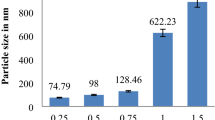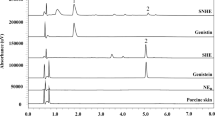Abstract
In the present study resveratrol nanoemulsion gel was developed and optimized with the aim of enhancing the permeability and antioxidant activity against ultraviolet (UV)-induced oxidative skin damage. Droplet size, polydispersity index, drug permeation flux, permeability coefficient and drug deposition in skin of resveratrol-loaded nanoemulsion were found to be 65.00 ± 5.00 nm, 0.171 ± 0.082, 144.50 μg/cm2/h, 2.90 × 10–2 cm/h and 45.65 ± 4.76%, respectively, whereas drug permeation flux, permeability coefficient and drug deposition in skin from nanoemulsion gel were found to be 107.70 μg/cm2/h, 2.06 × 10–2 cm/h and 62.65 ± 4.98%, respectively. Confocal studies depicted deeper penetration of resveratrol from nanoemulsion gel. Differential scanning calorimetry and Fourier-transform infrared spectrophotometer studies confirmed that nanoemulsion gel enhanced fluidization of stratum corneum lipids and conformational disruption of lipid bilayer, thereby enhancing skin permeation of resveratrol. Histopathology study of skin revealed that resveratrol-loaded nanoemulsion gel inhibited UV-induced spongosis, edema and epidermal hyperplasia response. Levels of glutathione, superoxide dismutase, catalase and protein carbonyl in the skin of UV-irradiated rats were significantly (p < 0.01) improved in the skin of animals treated with nanoemulsion gel. Experimental results suggested that nanoemulsion gel could be explored as a promising carrier for topical delivery of resveratrol for prevention of UV-induced oxidative skin damage owing to its enhanced permeability and retention effect.











Similar content being viewed by others
References
Schieber M, Chandel NS (2014) ROS function in redox signaling and oxidative stress. Curr Biol 24:R453–R462
Kryston TB, Georgiev AB, Pissis P, Georgakilas AG (2011) Role of oxidative stress and DNA damage in human carcinogenesis. Mutat Res 711:193–201
Sharma S, Narang JK, Ali J, Baboota S (2016) Synergistic antioxidant action of vitamin E and rutin SNEDDS in ameliorating oxidative stress in a Parkinson’s disease model. Nanotechnology 27:375101
Choudhari SK, Chaudhary M, Gadbail AR, Sharma A, Tekade S (2014) Oxidative and antioxidative mechanisms in oral cancer and precancer: a review. Oral Oncol 50:10–18
Darr D, Fridovich I (1994) Free radicals in cutaneous biology. J Investig Dermatol 102:671–675
Kruk J, Duchnik E (2014) Oxidative stress and skin diseases: possible role of physical activity. Asian Pac J Cancer Prev 15:561–568
Wiseman H, Halliwell B (1996) Damage to DNA by reactive oxygen and nitrogen species: role in inflammatory disease and progression to cancer. Biochem J 313:17–29
Addor FAS (2017) Antioxidants in dermatology. An Bras Dermatol 92:356–362
Ji H, Li XK (2016) Oxidative stress in atopic dermatitis. Oxidative Med Cell Longev 2016:1–8
Baur JA, Sinclair DA (2006) Therapeutic potential of resveratrol: the in vivo evidence. Nat Rev Drug Discov 5:493–506
Singh G, Pai RS (2014) Recent advances of resveratrol in nanostructured based delivery systems and in the management of HIV/AIDS. J Control Release 194:178–188
Summerlin N, Soo E, Thakur S, Qu Z, Jambhrunkar S, Popat A (2015) Resveratrol nanoformulations: challenges and opportunities. Int J Pharm. https://doi.org/10.1016/j.ijpharm.2015.01.003
Joraholmen MW, Skalko-Basnet N, Acharya G, Basnet P (2015) Resveratrol-loaded liposomes for topical treatment of the vaginal inflammation and infections. Eur J Pharm Sci 79:112–121
Kim JH, Park EY, Ha HK, Jo CM, Lee WJ, Lee SS, Kim JW (2016) Resveratrol-loaded nanoparticles induce antioxidant activity against oxidative stress. Asian Australas J Anim Sci 29:288–298
Pangeni R, Sharma S, Mustafa G, Ali J, Baboota S (2014) Vitamin E loaded resveratrol nanoemulsion for brain targeting for the treatment of Parkinson's disease by reducing oxidative stress. Nanotechnology 25:485102
Park S, Cha SH, Cho I, Park S, Park Y, Cho S, Park Y (2016) Antibacterial nanocarriers of resveratrol with gold and silver nanoparticles. Mater Sci Eng C Mater Biol Appl 58:1160–1169
Sessa M, Balestrieri ML, Ferrari G, Servillo L, Castaldo D, D'Onofrio N, Donsì F, Tsao R (2014) Bioavailability of encapsulated resveratrol into nanoemulsion-based delivery systems. Food Chem 147:42–50
Vinardell MP, Mitjans M (2015) Nanocarriers for delivery of antioxidants on the skin. Cosmetics 2:342–354
Teskac K, Kristl J (2010) The evidence for solid lipid nanoparticles mediated cell uptake of resveratrol. Int J Pharm 390:61–69
Pando D, Caddeo C, Manconib M, Fadda AM, Pazos C (2013) Nanodesign of olein vesicles for the topical delivery of the antioxidant resveratrol. J Pharm Pharmacol 65:1158–1167
Friedrich RB, Kann B, Coradini K, Offerhaus HL, Beck RC, Windbergs M (2015) Skin penetration behavior of lipid-core nanocapsules for simultaneous delivery of resveratrol and curcumin. Eur J Pharm Sci 78:204–213
Immacolata S, DanielaDe S, Virginia C, Laura M, Rosa C, Gabriella F, Fabio A, Maria IR, GiuseppeDe R (2013) Nanocarriers for topical administration of resveratrol: a comparative study. Int J Pharm 440:179–187
Kumar D, Ali J, Baboota S (2016) Omega 3 fatty acid-enriched nanoemulsion of thiocolchicoside for transdermal delivery: formulation, characterization and absorption studies. Drug Deliv 23:591–600
Anton N, Vandamme TF (2011) Nano-emulsions and micro-emulsions: clarifications of the critical differences. Pharm Res 28:978–985
Kumar S, Ali J, Baboota S (2016) Design Expert® supported optimization and predictive analysis of selegiline nanoemulsion via the olfactory region with enhanced behavioural performance in Parkinson’s disease. Nanotechnology 27:435101
Shakeel F, Baboota S, Ahuja A, Ali J, Aqil M, Shafiq S (2007) Nanoemulsions as vehicles for transdermal delivery of aceclofenac. AAPS Pharmscitech 8:191–199
Kumar A, Ahuja A, Ali J, Baboota S (2016) Curcumin-loaded lipid nanocarrier for improving bioavailability, stability and cytotoxicity against malignant glioma cells. Drug Deliv 23:214–229
Sharma S, Sahni JK, Ali J, Baboota S (2015) Effect of high-pressure homogenization on formulation of TPGS loaded nanoemulsion of rutin—pharmacodynamic and antioxidant studies. Drug Deliv 22:541–551
Shakeel F, Baboota S, Ahuja A, Ali J, Shafiq S (2008) Celecoxib nanoemulsion: skin permeation mechanism and bioavailability assessment. J Drug Target 16:733–740
Barakat NS (2010) Evaluation of glycofurol-based gel as a new vehicle for topical application of naproxen. AAPS Pharmscitech 11:1138–1146
Nguyen HX, Puri A, Banga AK (2017) Methods to simulate rubbing of topical formulation for in vitro skin permeation studies. Int J Pharm 519:22–33
Iqbal B, Ali J, Baboota S (2018) Silymarin loaded nanostructured lipid carrier: from design and dermatokinetic study to mechanistic analysis of epidermal drug deposition enhancement. J Mol Liq 255:513-529. https://doi.org/10.1016/j.molliq.2018.01.141
Ghate VM, Lewis SA, Prabhu P, Dubey A, Patel N (2016) Nanostructured lipid carriers for the topical delivery of tretinoin. Eur J Pharm Biopharm 108:253–261
Han F, Yin R, Che X, Yuan J, Cui Y, Yin H, Li S (2012) Nanostructured lipid carriers (NLC) based topical gel of flurbiprofen: design, characterization and in vivo evaluation. Int J Pharm 439:349–357
Pandey YR, Kumar S, Gupta BK, Ali J, Baboota S (2016) Intranasal delivery of paroxetine nanoemulsion via the olfactory region for the management of depression: formulation, behavioural and biochemical estimation. Nanotechnology 27:025102
Wan T, Xu T, Pan J, Qin M, Pan W, Zhang G, Wu Z, Wu C, Xu Y (2015) Microemulsion based gel for topical dermal delivery of pseudolaric acid B: in vitro and in vivo evaluation. Int J Pharm 493:111–120
Mayer S, Weiss J, McClements DJ (2013) Vitamin E-enriched nanoemulsions formed by emulsion phase inversion: factors influencing droplet size and stability. J Colloid Interface Sci 402:122–130
Naz Z, Ahmad FJ (2015) Curcumin-loaded colloidal carrier system: formulation optimization, mechanistic insight, ex vivo and in vivo evaluation. Int J Nanomed 10:4293–4307
Khurana S, Jain NK, Bedi PMS (2013) Nanoemulsion based gel for transdermal delivery of meloxicam: physico-chemical, mechanistic investigation. Life Sci 92:383–392
Harwansh RK, Mukherjee PK, Bahadur S, Biswas R (2015) Enhanced permeability of ferulic acid loaded nanoemulsion based gel through skin against UVA mediated oxidative stress. Life Sci 141:202–211
Author information
Authors and Affiliations
Corresponding author
Ethics declarations
Conflict of interest
The authors report no conflicts of interest.
Additional information
Publisher's Note
Springer Nature remains neutral with regard to jurisdictional claims in published maps and institutional affiliations.
Rights and permissions
About this article
Cite this article
Sharma, B., Iqbal, B., Kumar, S. et al. Resveratrol-loaded nanoemulsion gel system to ameliorate UV-induced oxidative skin damage: from in vitro to in vivo investigation of antioxidant activity enhancement. Arch Dermatol Res 311, 773–793 (2019). https://doi.org/10.1007/s00403-019-01964-3
Received:
Revised:
Accepted:
Published:
Issue Date:
DOI: https://doi.org/10.1007/s00403-019-01964-3




